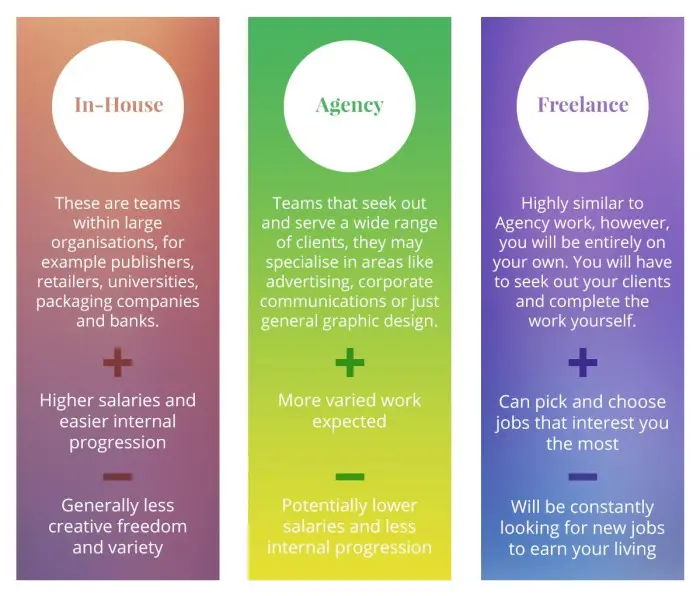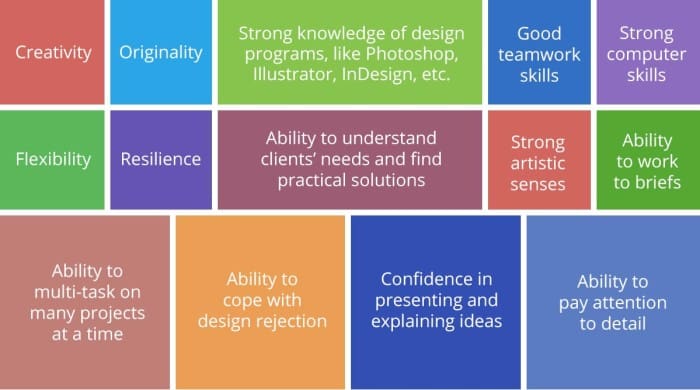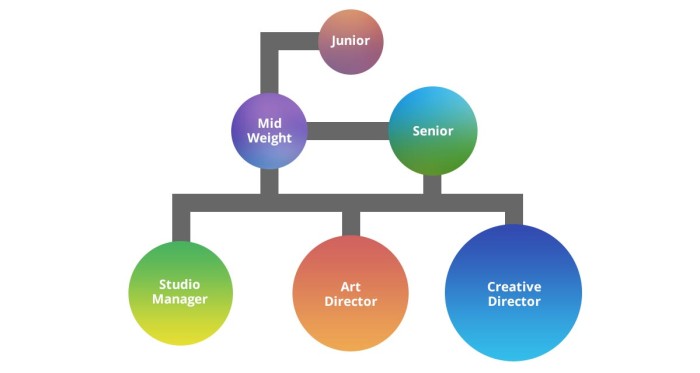What is Graphic Design?
Graphic design is using images and lettering to communicate information and ideas. Take a look at our Graphic Design Career Path and Progression Infographic to see the sort of things you can create in your role.
What are the Hours Like?
Typically, 37 hours a week, Monday to Friday. Extra hours are to be expected when deadlines draw near.
What Will I Be Doing?
Working on a variety of products, which will involve lots of sitting and long periods of working on a computer.
Products Include:
- Websites
- Packaging
- Books and magazines
- Branding
- Advertising
- Exhibitions and displays
- Computer games
What is the Environment Like?
Generally, studio/office based or home based if doing freelance work. Some travel to meet clients may be required.
What is the Difference Between In-House, Agency and Freelance?
In-House
These are teams within large organisations, for example, publishers, retailers, universities, packaging companies and banks.
Advantages: Higher salaries and easier internal progression
Disadvantages: Generally less creative freedom and variety
Agency
Teams that seek out and serve a wide range of clients, they may specialise in areas like advertising, corporate communications or just general graphic design.
Advantages: More varied work expected
Disadvantages: Potentially lower salaries and less internal progression
Freelance
Highly similar to Agency work, however, you will be entirely on your own. You will have to seek out your clients and complete the work yourself.
Advantages: Can pick and choose jobs that interest you the most
Disadvantages: Will be constantly looking for new jobs to earn your living
What Skills Will I Need to be a Graphic Designer?
- Creativity
- Originality
- Flexibility
- Resilience
- Strong knowledge of design programs, like Photoshop, Illustrator, InDesign, etc.
- Ability to understand clients’ needs and find practical solutions
- Good teamwork skills
- Strong computer skills
- Strong artistic senses
- Ability to work to briefs
- Ability to multi-task on many projects at a time
- Ability to cope with design rejection
- Confidence in presenting and explaining ideas
- Ability to pay attention to detail
Entry Requirements
A strong Portfolio of work is hugely important in getting into the business as it presents your abilities to your potential employer/clients.
Work Experience is nearly essential to get into the industry, as it will provide you with a reference and evidence of the work you have done, adding to your portfolio.
For any chance of progression, you will need a Foundation Degree, Higher National Diploma or Degree in Graphic Design or other art-related subjects such as Illustration, Fine Art, Visual Art, Photography, 3D Design, Communication Design and Film and Television. Most Graphic Designers will have these qualifications, which therefore makes progression without formal training difficult.
An enthusiastic and positive attitude will go a long way to helping you progress through the industry.
What is the Career Path of a Designer and What Can You Expect to be Doing in Each Role?
Junior Graphic Designer
This job will focus mainly on design busy work that other designers do not want to do like layouts, drawing logos, repeatedly redrawing logos, correcting typefaces and doing colour corrections. There will be moments of brainstorming ideas and mocking up designs. All will be done under the supervision of Senior Designers, which gives the opportunity for learning and development from those more experienced.
Satisfaction Rate: Very high
Advantages: Generally great work environment and the ability to grow portfolio
Disadvantages: Low pay and not always very creative work meaning it is sometimes monotonous
Graphic Designer
This job focuses on a much broader scale, carrying out entire processes from concept to design to layout to the final artwork sometimes independently. It will involve speaking directly with clients and while there is a greater amount of creative control than a Junior Designer would have, work is still overseen by more senior staff.
Satisfaction Rate: High
Advantages: Variety of work and highly creative
Disadvantages: Stressful due to non-design-trained clients expecting very quick turnovers and will suffer rejection of design ideas
Senior Graphic Designer
This job has a complicated set of responsibilities, which can range from meeting clients to taking control over entire advertising campaigns. The work will generally cover everything in conceptualising and design from beginning to end. The directors of your company will oversee your work, however, there is a much greater degree of creative freedom and you will be directing Junior and other Designers to complete large projects.
Satisfaction Rate: High
Advantages: Greater creative freedom and control over entire projects
Disadvantages: Stressful due to amount of work required and longer hours
Studio Manager
This job is similar to Senior Graphic Designers but focuses more on leading multiple design tasks and overseeing day-to-day operations. Will have the responsibility of delegating assignments and may also include hiring staff, conducting performance review assessments, and ordering resources all the while ensuring the work produced by the Designers is of a high enough quality.
Satisfaction Rate: Very high
Advantages: Position of responsibility and potential for collaboration across departments
Disadvantages: Stressful due to amount of management required
Art Director
This is arguably the most senior role in a Graphic Design firm. The focus does shift away from actual design to the marketing element of Graphic Design, but there is still the opportunity for creative work. You will frequently meet with clientele to establish their needs and work with Art Directors and Senior Design staff to ensure the clients’ needs are met.
Satisfaction Rate: Very high
Advantages: Great environment and potentially very high salary
Disadvantages: Very long hours and very stressful
Career Progression
Below illustrates the common career paths within the design industry:
Progression Tips
- The main route to successful progression is by; developing a reputation, networking and making contacts.
- Developing your career further depends on frequent job movement in order to widen experience and develop your portfolio. You need to think strategically about any moves you make.
- Smaller companies rarely have a career structure, but they may have a better work environment than larger companies. You may want to go freelance/self-employed to progress your career.
- Junior Graphic Designers generally progress after 2 or 3 years.
- Graphic Designers generally progress between 3 to 5 years.
- A lot of designers choose to go Freelance/Self-Employed within 5 to 10 years of having their first job.
Final Tips
- Ensure your CV is typographically great with a clear layout and no spelling errors or incorrect spacing. Giving it a creative design can be helpful but it is risky.
- Work on your Portfolio – Sometimes try tailoring it to the design company you’re applying to.
- Get as much experience as possible!
- Network, network, network.
- Learn and train as you go! Always make sure to keep up-to-date with the latest design software available.
- Be very enthusiastic and positive!



